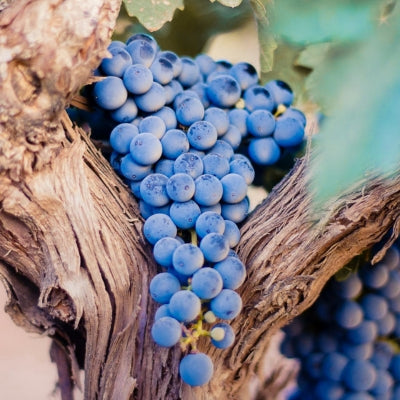
Grape school: Grenache
Grenache, known for its versatility and vibrant fruit notes, is one of the most widely planted red grape varieties in the world. With its origins in Spain, Grenache has become a staple in several prominent wine regions, from the Rhône Valley to Australia and California. Its adaptability to different climates and soils, along with its ability to produce both single-varietal wines and blends, has made it a favorite among winemakers and wine enthusiasts alike.
Origins and history
Grenache, known as Garnacha in Spain, is believed to have originated in the region of Aragon. From there, it spread to other parts of Spain, France, and eventually the rest of the world. In the 14th century, Grenache made its way to the Rhône Valley, where it became a key component in the celebrated wines of Châteauneuf-du-Pape.
Grenache's journey continued to the New World, where it as found new expression in California's Central Coast and Australia's McLaren Vale. Its ability to thrive in warm, arid climates has made it a popular choice for vineyards across diverse regions, each adding unique characteristics to the wine.
Appearance and growing conditions
Grenache grapes are typically medium-sized with thin skins that range from deep red to bluish-black. The vine is known for its hardy nature and can thrive in hot, dry climates where other grape varieties might struggle. It prefers well-drained soils, particularly sandy or stony soils, which help to stress the vine, concentrating the flavor.
Grenache's resilience makes it well-suited to regions with long growing seasons, where it can fully ripen and develop its characteristic sweetness and high alcohol content. Despite its robustness, Grenache can be susceptible to mildew and requires careful vineyard management to ensure healthy crops.
Flavor profile
Grenache is celebrated for its bright, juicy fruit flavors and aromatic complexity. Typical tasting notes include ripe red fruits such as strawberry, raspberry, and cherry, often accompanied by hints of white pepper, anise, and dried herbs. The grape's natural sweetness can lend a lush, full-bodied texture to the wine.
In warmer climates, Grenache can develop more intense, jammy fruit flavors, while cooler regions may produce wines with higher acidity and a more delicate profile. Oak aging can introduce additional layers of vanilla, spice, and tobacco, enhancing the wine's complexity and depth.
Food pairings
Grenache's vibrant fruitiness and moderate tannins make it a versatile partner for a wide range of dishes. Its natural sweetness and high alcohol content pair well with hearty, flavorful foods such as grilled meats, stews, and roasted vegetables. The wine's acidity can balance rich, fatty dishes, making it an excellent choice for lamb, pork, and duck.
For a classic pairing, consider Grenache with Mediterranean cuisine, such as ratatouille, paella, or grilled sausages. The wine's fruity and spicy notes complement the bold flavors and spices of these dishes, creating a harmonious and satisfying combination.
Notable producers
France remains a benchmark for high-quality Grenache, particularly in the Rhône Valley and the Southern Rhône's Châteauneuf-du-Pape, with esteemed producers like Château Rayas and Domaine du Pégau leading the way. In Spain, aside from its inclusion in Rioja blends, the Priorat region is most notable for producers such as Alvaro Palacios and Clos Erasmus championing Grenache expressions.
In the New World, California's Central Coast has gained acclaim for its Grenache wines, with wineries such as Sine Qua Non and Tablas Creek producing exceptional examples. Australia's McLaren Vale is another prominent region, with producers like d'Arenberg and Clarendon Hills gaining recognition for their distinctive Grenache wines.
Conclusion
Grenache's versatility, vibrant flavors, and resilience have secured its place as one of the world's most cherished grape varieties. From the rich, robust wines of Châteauneuf-du-Pape to the bright, fruit-forward expressions from Spain and the New World, Grenache offers a diverse array of styles that can appeal to any palate. Its adaptability and ability to produce both single-varietal wines and blends ensure that Grenache remains a cornerstone of the wine world.
Want to read more? Take a look at some of our other blogs:



